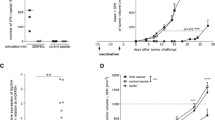Summary
To investigate the invasive ability of the residual tumor cells after immunotherapy and explore the feasible approach suppressing the invasion, mice were inoculated with B16 cells, and then treated by gene therapy with p4-1BBL/psPD-1 or IFN-γ. The production and activities of MMP-9 and MMP-2 in residual tumor tissues were analyzed with gelatin zymography 1 day and 7 days after the termination of the immunotherapy. The production of MMP-9 and MMP-2 by B16 cells treated with IFN-γ was also analyzed. IFN-γ-treated B16 cells were inoculated to mice via subcutaneous injection. The invasion of tumor to muscular tissue was analyzed. Gene therapy with CH50 was used to suppress the invasive growth of tumor. The results showed that the expression and the activities of MMP-9 and MMP-2 were significantly increased 7 days after the end of immunotherapy. The response of tumor cells to ECM molecules was intensified after the removal of IFN-γ, resulting in significant increase of both the production and activities of MMP-9 and MMP-2, and the increased invasion of tumor. Gene therapy with CH50 effectively suppressed the invasive growth of tumor. It is concluded that the termination of immunotherapy may result in a higher metastatic potential of residual tumor cells. Suppressing tumor invasion by suitable treatment will improve the efficacy of immunotherapy.
Similar content being viewed by others
References
Xiao H, Huang B, Yuan Y et al. PD-1 facilitates 4-1BBL-triggered antitumor immunity against murine H22 hepatocarcinoma in vivo. Clin Cancer Res, 2007,13:1823–1830
Cheng Y, Dong Q, Sun L R et al. Correlation between expression of MMP-2, MMP-9, TIMP-2, TIMP-1 and metastasis of neuroblastoma. Chin J Oncol, 2005,27(3):164–166
Kerkelä E, Saarialho-Kere U. Matrix metalloproteinases in tumor progression: focus on basal and squamous cell skin cancer. Exp Dermatol, 2003,12:109–125
He Y F, Zhang G M, Wang X H et al. Blocking programmed death-1 ligand-PD-1 interactions by local gene therapy results in enhancement of antitumor effect of secondary lymphoid tissue chemokine. J Immunol, 2004,173:4919–4928
He Y F, Wang X H, Zhang G M et al. Sustained low-level expression of interferon-γ promotes tumor development: Potential insights in tumor prevention and tumor immunotherapy. Cancer Immunol Immunother, 2005,54:891–897
Liu Y, Huang B, Yuan Y et al. Inhibition of hepatocarcinoma and tumor metastasis to liver by gene therapy with recombinant CBD-HepII polypeptide of fibronectin. Int J Cancer. 2007;121:184–192.
Yoshida H, Katayose Y, Unno M et al. A novel adenovirus expressing human 4-1BB ligand enhances antitumor immunity. Cancer Immunol Immunother, 2003,52:97–106
Yurkovetsky Z R, Shurin G V, Barry D A et al. Comparative analysis of antitumor activity of CD40L, RANKL, and 4-1BBL in vivo following intratumoral administration of viral vectors or transduced dendritic cells. J Gene Med, 2006,8:129–137
Cheuk A T, Mufti G J, Guinn B A. Role of 4-1BB:4-1BB ligand in cancer immunotherapy. Cancer Gene Ther, 2004,11:215–226
Gollob J A, Sciambi C J, Huang Z et al. Gene expression changes and signaling events associated with the direct antimelanoma effect of IFN-gamma. Cancer Res, 2005,65:8869–8877
Karmakar S, Dhar R, Das C. Inhibition of cytotrophoblastic (JEG-3) cell invasion by interleukin 12 involves an interferon gamma-mediated pathway. J Biol Chem, 2004, 279:55297–55307
Belperio J A, Keane M P, Arenberg D A et al. CXC chemokines in angiogenesis. J Leukocyte Biol, 2000,68:1–8
Dias S, Boyd R, Balkwill F. IL-12 regulates VEGF and MMPs in a murine breast cancer model. Int J Cancer, 1998,78:361–365
Mitola S, Strasly M, Prato M et al. IL-12 regulates an endothelial cell-lymphocyte network: effect on metalloproteinase-9 production. J Immunol, 2003,171:3725–3733
Rüegg C, Yilmaz A, Bieler G et al. Evidence for the involvement of endothelial cell integrin alphaVbeta3 in the disruption of the tumor vasculature induced by TNF and IFN-gamma. Nat Med, 1998,4:408–414
Strasly M, Cavallo F, Geuna M et al. IL-12 inhibition of endothelial cell functions and angiogenesis depends on lymphocyte-endothelial cell cross-talk. J Immunol, 2001,166:3890–3899
Yu Z R, Zhang G M, Li D et al. The inhibitory effect of recombinant polypeptide CH50 of fibronectin on invasion and angiogenesis of tumors. Chin J Oncol, 2006,28(11):815–819
Author information
Authors and Affiliations
Corresponding author
Additional information
Ting XIONG, female, born in 1983, Graduate Student
This project was supported by a grant from the National Natural Science Foundation of China (No. 30772589).
Rights and permissions
About this article
Cite this article
Xiong, T., Peng, H., Chen, G. et al. The expression and activity of MMPs are increased in residual tumor tissues after the termination of immunotherapy. J. Huazhong Univ. Sci. Technol. [Med. Sci.] 28, 375–378 (2008). https://doi.org/10.1007/s11596-008-0401-5
Received:
Published:
Issue Date:
DOI: https://doi.org/10.1007/s11596-008-0401-5




